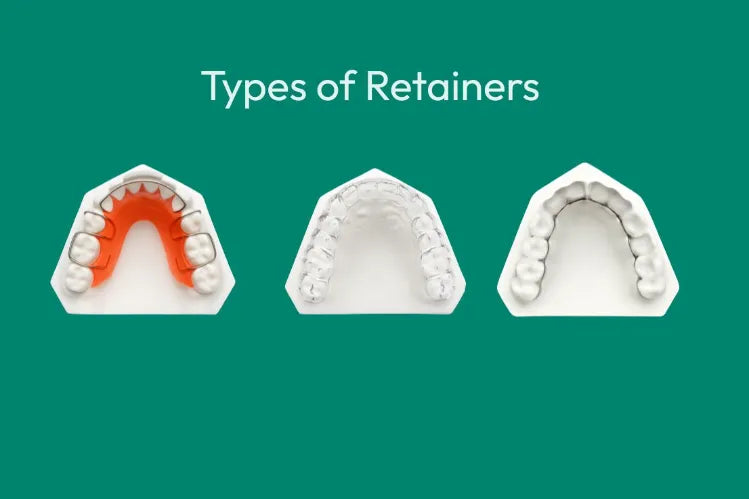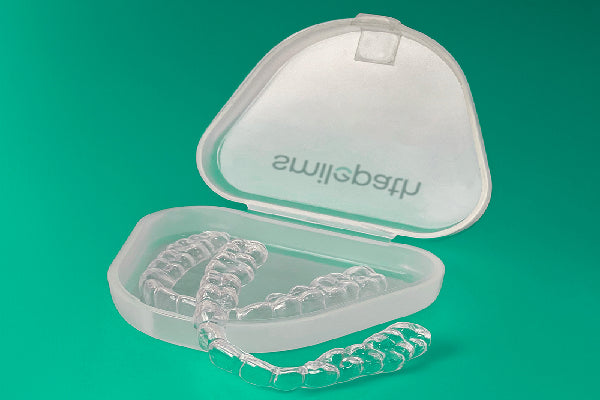
Table of Contents
- What Are Retainers and Why Are They Important?
- Types of Retainers
- Fixed vs Removable Retainers
- Cost of Retainers in Australia
- How to Clean Retainers
- How Long Do You Need to Wear Retainers?
- Retainers and the Australian Lifestyle
- Why Choose Smilepath?
- Ultimate Guide to Retainers; All You Need To Know
- FAQs
Completing your braces or aligner treatment marks a significant milestone, but your orthodontic journey continues. Once your teeth are straightened, the next thing to do is to maintain your perfect smile. In order to maintain your smile, you need retainers.
Retainers are critical teeth retention devices that are used after you have completed treatment with braces or aligners. They prevent your teeth from returning to their original misaligned position. Many patients in Australia do not recognize how important their post-treatment care is, and it is the most overlooked step in your braces or aligner treatment.
This complete guide is designed to give you everything you need to know about retainers. You will get to know different types of retainers, the cost of retainers in Australia, how to clean your retainers, the differences between fixed and removable retainers, and, of course, why Smilepath is a trusted provider, providing long-term smile retention.
What Are Retainers and Why Are They Important?
Retainers are custom-made teeth retention devices that help hold your teeth in their new positions after you’ve completed your orthodontic treatment. When braces or aligners move your teeth into alignment, your gums and surrounding bone structures take time to adapt. During this transitional period, there’s a strong chance that your teeth will begin to shift back to their previous position, a process called relapse.
Retainers prevent this from happening by “retaining” your teeth in their corrected alignment until the tissues around them have stabilized. For many people who invest in orthodontic treatment, using a retainer is non-negotiable if they want their results to last.
Orthodontists typically recommend post-braces retainers immediately for 20–22 hours a day, gradually reducing to nightly use. However, lifelong retainer use is often suggested, particularly during sleep, to ensure teeth remain in place for a longer period of time.
Types of Retainers
Selecting the right type of retainer is one of the key decisions you'll face after your treatment. In Australia, patients generally have access to three main types: Hawley, clear plastic, and fixed (or bonded) retainers.
Hawley Retainers

Hawley retainers are the traditional wire retainers made from stainless steel and moulded acrylic. The wire sits across the front of your teeth, and the acrylic plate fits comfortably on the roof of your mouth or behind your lower teeth.
Pros:
- Durable and long-lasting
- Adjustable by an orthodontist
- Allows the bite to settle naturally
Cons:
- Visible wire
- Less comfortable than clear options
These are a good choice for patients who want durability and minor post-treatment adjustments.
Clear Plastic Retainers

Also known as Essix or Vivera retainers, these are made from transparent plastic and fit snugly over your teeth. They are very similar to clear aligners but are designed for retention, not movement.
Pros:
- Virtually invisible
- More comfortable and aesthetic
- Easy to wear
- Easy to maintain oral hygiene with
Cons:
- Less durable than Hawley retainers
- Can warp or crack over time
- Not adjustable
These are ideal for adults and teens who are conscious about appearance and want a less noticeable option.
Fixed Retainers

Fixed retainers consist of a thin wire bonded to the back of your front teeth. Also known as permanent or lingual retainers, these are not removable and are commonly used for lower front teeth, where relapse is most likely to happen.
Pros:
- Cannot be forgotten or lost
- Continuous support for high-risk teeth
- Invisible from the outside
Cons:
- Harder to clean
- Can break or debond over time
- Not suitable for all teeth
If you’re prone to forgetting or losing items, this type might be ideal for you.
Fixed vs Removable Retainers
When deciding between fixed and removable retainers, it’s essential to consider a variety of factors, such as your lifestyle, personal habits, and overall dental health. Each type of retainer comes with its own set of advantages and disadvantages, making the decision highly individual.
Fixed Retainers
Fixed retainers are often recommended due to their high effectiveness in maintaining tooth alignment over the long term. They are particularly beneficial for those who prefer a hands-off approach to post-orthodontic care, as they remain in place without the need for daily action.
However, they do require a commitment to oral hygiene. Flossing can be particularly challenging with a fixed retainer because the wire is bonded to the back of the teeth. Many individuals find that using specialized tools such as floss threaders or interdental brushes can help maintain good oral health without compromising the retainer's functionality.
Removable Retainers
On the other hand, removable retainers offer greater flexibility. They can be taken out during meals and while brushing, allowing for easier maintenance of oral hygiene. This feature is particularly appealing for those who prefer convenience or have concerns about aesthetics during special occasions.
However, the effectiveness of removable retainers greatly depends on consistent wear. If a retainer is not worn as recommended—often for 20-22 hours a day—it can lead to the gradual shifting of teeth back to their original positions. This means that discipline is essential for those opting for this kind of retainer.
Ultimately, the best choice depends on your circumstances, preferences, and the guidance of your orthodontist. Taking the time to evaluate what suits your lifestyle can lead to successful and lasting results in maintaining your beautiful smile.
Cost of Retainers in Australia
People often ask: How much do retainers cost? The cost of retainers in Australia varies depending on the type of retainer, the dental provider, and whether it’s included in your orthodontic treatment package. Here's a general cost breakdown:
| Retainer Type | Cost (AUD) |
| Hawley Retainer | $150 – $300 per set |
| Clear Plastic Retainer (Smilepath) | per set |
| Fixed Retainer | $350 – $700 per set |
Some orthodontists include one set of retainers in your total treatment cost. However, replacement retainers are typically charged separately. Given their importance, many Australians find it beneficial to invest in a backup pair.
Smilepath offers a more affordable and convenient solution. With clear, custom-made retainers delivered directly to your door, we provide top-quality products at prices significantly lower than traditional clinics.
Our retainers are designed to be worn comfortably and are crafted with medical-grade materials for longevity and clarity.
How to Clean Retainers
Proper care and cleaning of your retainers are essential to maintaining both oral hygiene and the lifespan of the device. Whether you’re using removable retainers or a fixed retainer, keeping them clean is vital. Here’s how to clean retainers properly:
Cleaning Removable Retainers
- Rinse after Removal: Always rinse your retainer with lukewarm water after taking it out. This helps remove saliva and debris.
- Brush Gently: Use a soft-bristled toothbrush and non-abrasive cleaner (like mild dish soap). Avoid toothpaste, as it can scratch clear plastic retainers.
- Soak Weekly: Use a retainer cleaning tablet or a homemade solution (like a mix of white vinegar and water) to soak the retainer for 15-20 minutes at least once a week.
- Avoid Heat: Never use boiling water, dishwashers, or microwaves. High temperatures can warp your retainer.
Cleaning Fixed Retainers
- Floss Daily: Use floss threaders or water flossers to clean between the wires and teeth.
- Brush Carefully: Angle your toothbrush to clean above and below the wire. Take extra care around the bonding points.
- Dental Visits: Schedule regular dental cleanings. Fixed retainers can trap plaque, making professional cleaning essential.
Keeping your retainers clean is not only about appearance; it also prevents bad breath, tooth decay, and gum disease.
How Long Do You Need to Wear Retainers?
This is one of the most common questions asked by Australians: How long to wear retainers after braces? The truth is, retention is a lifelong process. While you may reduce the frequency of use over time, you’ll likely need to wear a retainer at night indefinitely.
For the first three to six months, orthodontists usually recommend wearing retainers full-time (excluding meals). After that, most people switch to nighttime wear for life.
Skipping even a few days can lead to noticeable shifting, especially in the first year post-treatment.
Retainers and the Australian Lifestyle
Australians are known for being active, outdoorsy, and busy. That’s why choosing the right retainer is about more than dental advice—it’s also about practicality.
Clear retainers are great for professionals who want something discreet. Fixed retainers are perfect for surfers, travellers, and athletes who might forget to wear removable devices. Kids and teens often benefit from brightly coloured cases and reminders to maintain their routine.
Smilepath caters to Australian lifestyles with solutions that fit into your routine seamlessly. Whether you're backpacking along the East Coast or managing a hectic work schedule, our retainers are built to match your lifestyle.
Why Choose Smilepath?
When it comes to teeth retention devices, you need more than just a product—you need a partner in long-term smile care. At Smilepath, we pride ourselves on offering Australian customers a premium yet affordable option for maintaining their straight teeth.
Here’s what makes us different:
- Custom-made retainers crafted with medical-grade material
- Home-delivered kits with easy-to-follow instructions
- Affordable pricing without compromising on quality
- Supportive customer service tailored for Aussie users
Our products are backed by dental professionals, designed for daily comfort, and made to preserve the smile you worked hard to achieve.
Whether you’re a recent Smilepath aligner user or you had braces years ago, our retainers are built to serve your retention needs now and in the future.
Ultimate Guide to Retainers; All You Need To Know
While retainers may not be the most exciting part of orthodontic treatment, they’re arguably the most necessary. Without a reliable retainer, all the time, money, and effort dedicated to straightening your teeth can be wasted.
By now, you should have a good understanding of the various types of retainers, the average retainer costs in Australia, how to look after your retainer, and the differences between fixed vs removable retainers. You are now equipped to make informed choices about your oral health care for the long run.
Orthodontic relapse is preventable; you just need the proper tool and consistent wear. At Smilepath, we're here to help make sure that your smile stays straight, healthy, and confident.
If you’re looking for high-quality yet affordable retainers in Australia, Smilepath can help. Get in touch to find out more or order your custom retainers directly.
FAQs
Depending on the type, retainers typically cost between $150 - $700 per arch.
Wear them full-time for the first few months, then nightly for life (or as your orthodontist advises). Always take off removable retainers while eating or drinking anything other than water.
In Australia, removable retainers cost around $150–$300, while fixed retainers can range from $350–$700 per arch.
Citations:
Professional, C. C. M. (2025w, June 30). Teeth Retainer. Cleveland Clinic. https://my.clevelandclinic.org/health/treatments/10899-teeth-retainer
American Association of Orthodontists. (2025c, July 10). Retainers after orthodontic treatment | American Association of Orthodontists (AAO). https://aaoinfo.org/treatments/retainers/#:~:text=A%20retainer%20is%20a%20device,over%20or%20behind%20the%20teeth.







 Australia
Australia New Zealand
New Zealand Malaysia
Malaysia English
English Portuguese
Portuguese English
English English
English English
English English
English English
English Canada
Canada